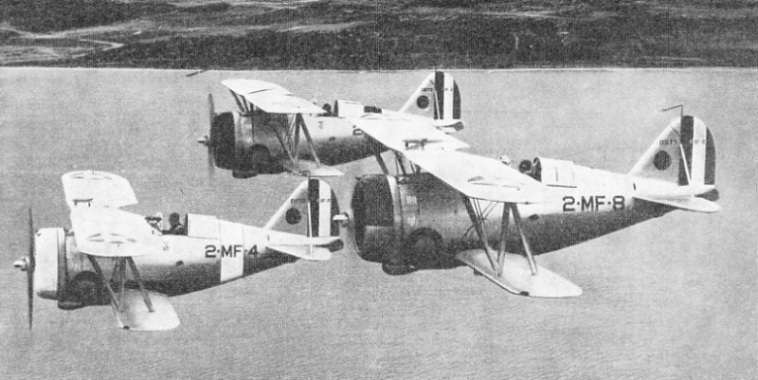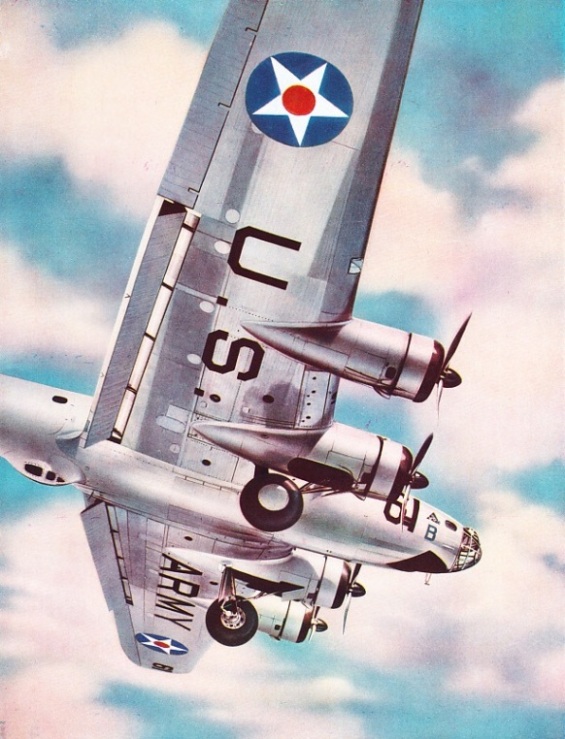
© Wonders of World Aviation 2015-




Part 34
Part 34 of Wonders of World Aviation was published on Tuesday 25th October 1938, price 7d.
This part included a colour plate showing a Boeing B-17B bomber . This was one of the illustrations in the article on The United States Air Force.
This illustration had previously appeared as the cover design of Part 19.
The Cover
This week’s cover shows one of British Airways’ Lockheed Electra air liners at Croydon.
An article on British Airways appeared in Part 25.
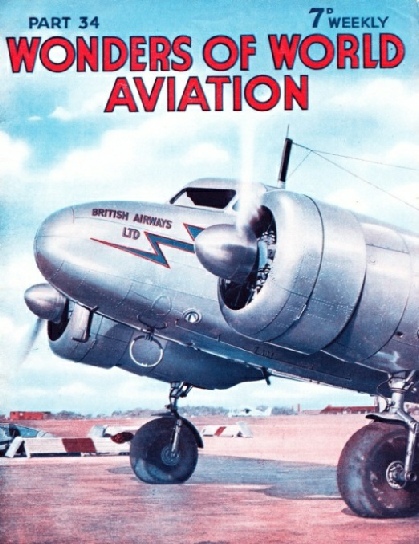
Contents of Part 34
Triumph and Tragedy in the Arctic (Part 2)
The Short Empire Flying Boat
Air Forces of the Dominions
Construction of Rigid Airships
Poland’s Achievement
The United States Air Force
Boeing B-17B Bomber (colour plate)
Holland’s Famous Designer-Pilot (Part 1)
The Short Empire Flying Boat
A description of the Short Empire Flying Boats, built by Short Brothers Ltd, of Rochester, Kent. They were built to specifications laid down by Imperial Airways after many years experience flying to schedule on their long transoceanic and transcontinental flights. This is the third article in the series on Famous Aircraft.
You can read more on Short Empire Flying Boats in Wonders of World Engineering.
Construction of Rigid Airships
The description of airship construction in this chapter is largely based on that of the German airship Hindenburg. From a general point of view the methods described are applicable to any modern airship, but where figures are given they apply specifically to the Hindenburg.
You can read more on Airship Design and Equipment in Wonders of World Engineering.
An Early Commercial Cabin Aeroplane
AN EARLY COMMERCIAL CABIN AEROPLANE used on a Soviet airline between Moscow and Konigsberg (East Prussia). The aircraft, a five-seater Fokker III, was built in Germany and had a 360 horse-power Rolls-Royce engine. Fokker was a pioneer of commercial flying after the war of 1914-18 and introduced the first commercial cabin aeroplane when nearly all aircraft for commercial work were converted warplanes.
The Airship “Norge”
THE ITALIAN-BUILT AIRSHIP NORGE, a sister ship to the Italia, leaving King’s Bay on May 11, 1926, for her successful flight over the North Pole. The airship was bought from the Italian Government for the purpose of this expedition, and was flown to King’s Bay by stages from Italy. Amundsen chose an airship for the flight because he had previously been unsuccessful in an attempt to take an aeroplane expedition over the North Pole.
Triumph and Tragedy in the Arctic (Part 2)
The concluding part of the chapter describing the flight of the Norge and the last voyage of the Italia, sister ship of the Norge. The article is concluded from part 33.
Boeing B-17B Bomber
A FOUR-ENGINED BOEING B-17B BOMBER of the United States Army. These aircraft are noteworthy for their performance when carrying heavy loads. They have a top speed of over 250 miles an hour, carry a crew of nine and have five machine-guns. One gun position is in the nose and the other four positions are in the form of “blisters” in the sides, top and bottom of the fuselage. Four 1,0000 horse-power radial air-cooled Wright Cyclone engines are fitted which dive three-bladed constant-speed propellers. Split trailing-edge flaps, and retractable type undercarriage are used. The wing span is 105 feet, the length 70 feet and the height 15 feet.
This colour plate previously appeared as the cover design to Part 19.
Anthony Fokker: Holland’s Famous Designer-Pilot (Part 1)
One of the most interesting and remarkable figures in the story of aviation is the famous Dutch pilot-designer Anthony Fokker. He is a genius, and I use that word fully conscious of the freedom with which it is often used to describe people who are not geniuses. His influence on tactics, in the air and on the ground, during the war of 1914-18 was remarkable. I doubt if any one man had so profound an effect on the war as did Anthony Fokker. During the war, when he was designing and building aeroplanes for Germany, he was the centre of acute and bitter controversy because of his association with Germany. In this chapter, Fokker’s reasons for his decision to work for Germany are given. Fokker’s life story is told from his boyhood to his position as one of the greatest of the makers of air history.
The article is the fourteenth in the series Makers of Air History and is concluded in part 35.
The Short Empire Flying Boat “Corinna”
AN ALL-METAL CANTILEVER MONOPLANE, the Empire Flying Boat Corinna measures 88 feet from nose to tail. It has a wing span of 114 feet and a wing area of 1,500 square feet. Four Bristol Pegasus radial air-cooled engines are fitted.
Air Forces of the Dominions
This chapter describes the air forces of the Dominions and Empire. Compared with the Royal Air Force at home and with the air forces of other nations, the air strength of the Empire is numerically small; but its value cannot be measured by numbers. The Dominion air forces are a strong potential reserve. In 1936 and 1937 four hundred and thirty pilots from the Dominions joined the Royal Air Force at home. One of the most recent of the Empire’s air forces, and one which holds almost a unique position in that it can take part in active service on the borders of its own country, is that of India. The Indian air force, which was founded in 1932, is composed entirely of Indians. In other parts of the Empire small air sections have been formed; and they may develop into air forces on a larger scale. In 1936 there was founded the Straits Settlements Volunteer Air Force, and there are air sections of the defence forces in Kenya, Southern Rhodesia and Ceylon.
An Inspection at Point Cook, Victoria
AN INSPECTION AT POINT COOK, VICTORIA, of the Royal Australian Air Force Station by the Governor-General in 1935. Pilots are given a twelve-months’ course at No. 1 Flying School, which was founded at Point Cook as early as 1912. Special attention is given to navigation, on which so much depends during flights across the vast tracts of virtually unknown country in Australia.
Polish Air Lines
The Poles have used aviation as an instrument first to aid the winning of their freedom and then as a method of communication and transport. Polish achievements in gliding, the flying of light aeroplanes and ballooning are considerable. In this chapter all forms of aviation that have thriven since 1918 are described.
This is the sixteenth article in the series on Air Routes of the World.
Single-Seat Grumman Fighters
SINGLE-SEAT GRUMMAN FIGHTERS used for deck landings on American aircraft carriers. An interesting feature of these aeroplanes is the combination of biplane construction and retractable undercarriages. The wheels are drawn up during flight into recesses at the sides of the fuselage just behind the engines, which are of air-cooled radial type. Curtiss-Wright and Grumman aircraft designed on similar lines have for long been popular types in the American Air Services.
The “Hindenburg”
AN AIRSHIP’S GENERAL DESIGN is illustrated by this sectionalized diagram of the Hindenburg. The illustration shows 1, inter-girder bracing wires; 2, gasbags; 3, longitudinal girder; 4 and 7, main frames; 5 and 6, intermediate frames; 8, axial girder; 9, gas and ventilation duct; 10, gas-release valve; 11, gangway built in axial girder; 12, resilient wire bulkhead between gasbags; 13, radio room; 14, upper deck; 15, lower deck.
A Lockheed Electra Aircraft Operated by Polske Linje Lotnicze
AIR LINES ARE OPERATED IN POLAND by the civil aviation company Polske Linje Lotnicze, whose representative letters L.O.T. Are seen on the side of this Lockheed Electra aircraft. One of the company’s most important routes is that to Berlin; its is operated in conjunction with the German company Deutsche Lufthansa. A daily service in either direction is provided.
The United States Air Force
In America, commercial aviation has led the way in technique and production of aircraft. It is a condition unknown elsewhere. In most other countries military aviation leads the way and commercial aviation is a subsidized addition to it. In America the constructors of commercial aircraft are all the time in advance of the constructors of military machines. The Americans have also retained the principle of two separate services, one for the Navy and the other for the Army, and the air forces are divided between them.
It is the fourth article in the series on Air Fleets of the Nations.
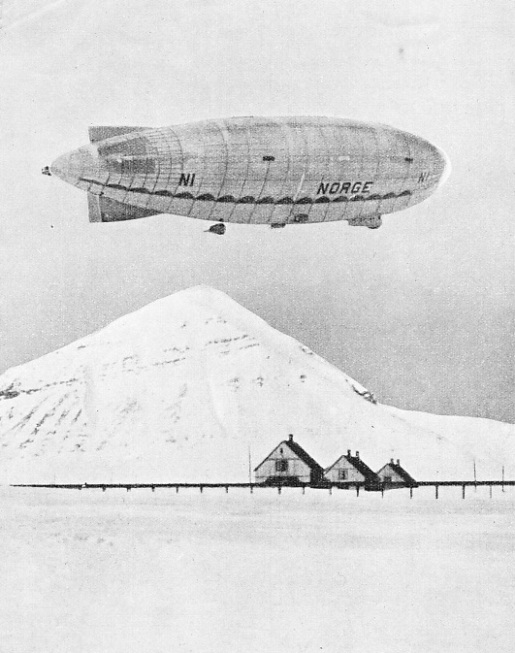
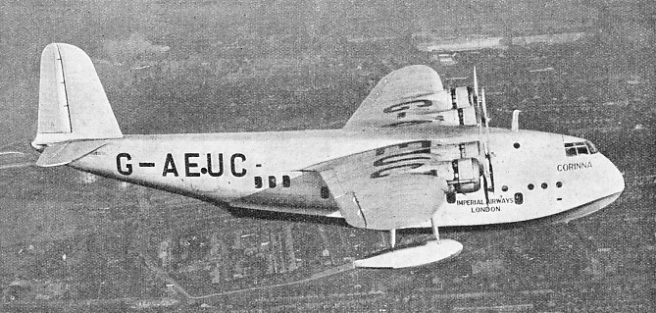
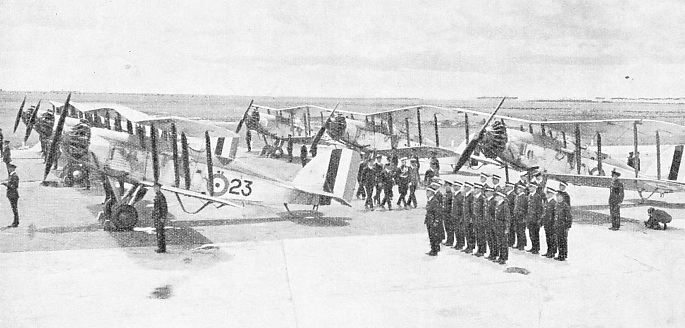
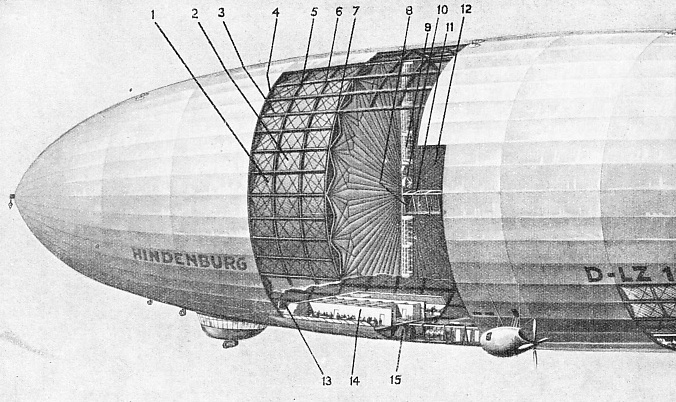

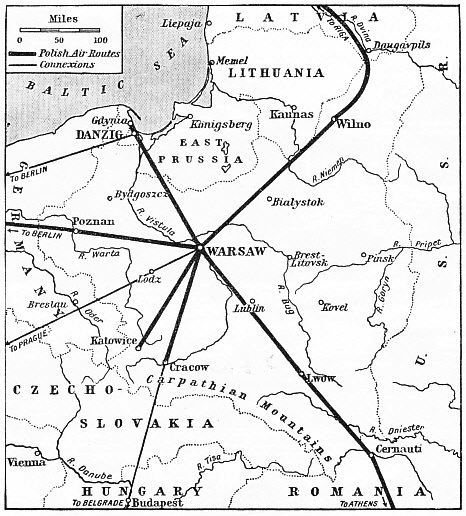
Polish Air Routes
POLAND IS DIRECTLY LINKED BY AIR with many of the capitals of Europe. Warsaw is near the centre of the country and makes an ideal point for the operation of air services. Important civil customs aerodromes along the Polish international air routes are situated at Lwow, Poznan and Wilno. South-eastwards from Warsaw a trunk route that extends by way of Athens to Palestine.
